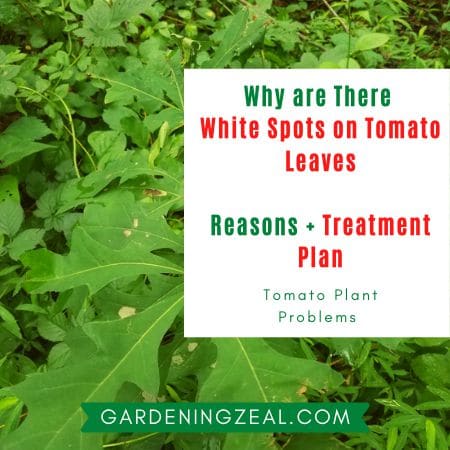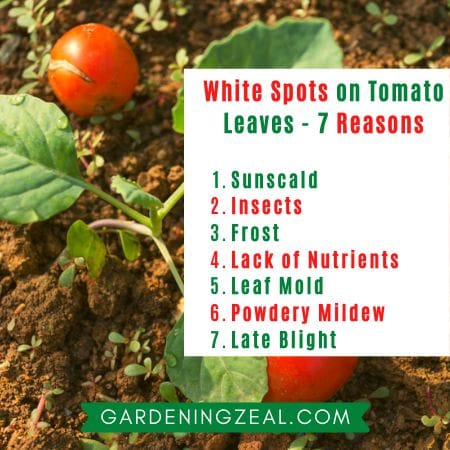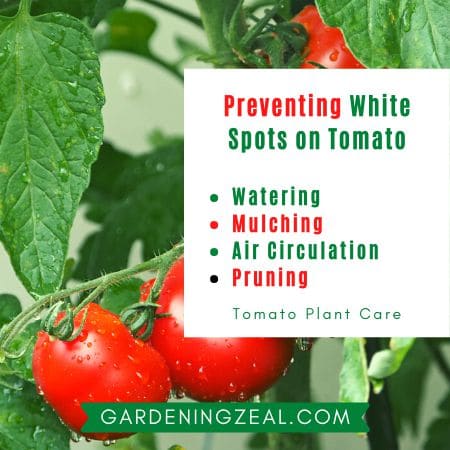Seeing white spots on tomato leaves can be concerning for any gardener who has spent months growing the plant, waiting to harvest those beautiful red tomatoes- but what causes these patches?
White spots on leaves are caused by several reasons, including sunburn, insect bite, frostbite, nutritional deficiencies, mold growth, and a fungal disease called powdery mildew. All of these negatively affect the health of your plant and need a prompt treatment course.
Most plant issues can be cured by addressing the root cause and preventing further damage. In this article, we’ll discuss all these problems and their treatments, so your plant remains healthy and grows gorgeous plump tomatoes.
Key Learning Points
Main Reasons of White Spots on Tomato Leaves – Treatment

1. Sunscald
Sunscald or sunburn is a common occurrence when plants are exposed to harsh sunlight for extended periods. Tomato, or any other vegetable leaves, can get sunburnt fast if planted directly under the sun. It’s a mistake a lot of beginner gardeners make- even though tomato plants thrive in the sun, more sunlight is not always necessarily better.
Sunburnt leaves often have white slivers in their center but can appear as patches. It’s more common in young plants and seedlings.
Leaves also look scrunched up when they’re sunburnt, so if you notice an abundance of white and faint green with a wilted-looking leaf, sunlight is the likely culprit. Another way to diagnose a sunburnt plant is by looking at the tomatoes- they will likely have blisters and burns.
In addition to bright sunlight, sunburn can be caused by a sudden change in the plant’s location. Moving a plant usually kept indoors that gets filtered light under the intense sun for a prolonged period can also cause leaves to turn white.
How To Treat It:
Sunburns don’t go away, but they don’t affect healthy plants much. Tomato plants need about 6-9 hours of sunlight a day. Too little and fungus may grow, too much and sunburn may occur. To avoid sunburn blisters, install a shade that allows light to constantly filter through while direct exposure is available for a few hours daily.
If you’re introducing a plant to sunlight, make sure to do it gradually, so the plant has time to adjust instead of a radical change. Plants hate getting blasted by heat and light, no matter how important they are.
2. Insect Bite
If you’ve found tiny white spots on tomato leaves that are scattered and look cloudy, it may be a stinkbug bite. Stinkbugs don’t attack the leaves only, though, and you will likely find similar spots on the fruit as well.
Other bugs like thrips, spider mites, and aphids might be causing these spots. However, they’re never as active as stinkbugs. Stinkbug bites can also be distinguished by their presence under the leaf and below the tomato’s skin.
How To Treat It:
Insect bites don’t spread, so your only focus should be keeping the bugs away. Instead of buying an insecticide, you can use something like Neem oil or dichotomous earth. A sharp mulch also keeps bugs at bay.
3. Frostbite
On the other end of the spectrum of sun and heat damage is frostbite. If you live in a cold climate where temperatures can drop well below 5C (40F) in winters, unprotected plans exposed to the atmosphere can get frostbites quickly.
Thankfully, frostbites are never too detrimental to your plant’s health and can be easily spotted. Tomato leaves get frostbite near the vein, where they initially appear white but then turn tan or brown. White ice crystals line the leaves, and the stems appear sunken too. Younger plants are more vulnerable to cold.

How To Treat It:
Frostbite is cured by raising the temperature. You can do this by watering them (yes, it sounds counterintuitive, but it works), providing a covering at night, and using mulch. Also, a little tip is not to prune the plants until temperatures get warmer. That way, the new foliage and growth isn’t affected.
4. Nutritional Deficiency
An important deciding factor for a plant’s health is the kind of soil and fertilizer you use. Fertilizers and mulches are crucial for a plant to remain healthy and grow those Instagram-worthy tomatoes.
Using a fertilizer that doesn’t fulfill a plant’s nutritional needs can cause its leaves and stem to show white and faint yellow spots. Patchy leaves may be a sign of deficiency of essential minerals like magnesium, potassium, calcium, nitrogen, and phosphorus.
How To Treat It:
Nutritional deficiency can be treated using compost or fertilizer with a balanced nutrient supply. Fertilizers with both nitrogen and phosphorus base are better. Magnesium deficiency can be addressed by using Epsom salt. Calcium can be added by powdered lime mixed with soil. A good source of potassium for your compost is kelp.
5. Leaf Mold
If the white blotches on your tomato plant leaves are not due to weather, insects, or nutrition, then it’s likely a disease.
One of the most common diseases blighting tomato plants is the tomato leaf mold, caused by a fungus called Passalora fulva, which affects thousands of plants worldwide. It’s mostly present in greenhouses, though it can spread in any climate with high humidity.
Leaf mold can be observed as faint white-yellow patches when the mold is not at the sporulation stage. Once it starts spreading by spores fast, the white often turns brown. In severe cases, it can even affect the fruit. Hence it’s a disease that needs to be addressed quickly.
How To Treat It:
Leaf mold can be treated by pruning affected leaves and using a simple fungicide. Exposure to a good amount of air and sunlight can also treat the issue on its own.
6. Powdery Mildew
Another cause of tomato plant white leaf spots is powdery mildew, another type of fungal disease. These are the most distinctive white spots that appear as round white blotches. If they persist for a long time, they leave dead tissue behind, turning leaves brown and causing them to wilt.
Powdery mildew is brought by wind and grows at accelerated speeds in high humidity and shady, moist environments. Plants that receive little to no air or sunlight can also be affected by mildew. Consistent mildew growth is facilitated by excessive use of fertilizer and overwatering.
Powdery mildew isn’t known to harm plants significantly, though, and your plant will most likely live. However, it can affect the flavor of tomatoes and significantly reduce your yield.
How To Treat It:
Powdery mildew has two steps to treatment. First is pruning- make sure to get all affected areas removed and properly sanitize your equipment. If more than half the leaves are affected, remove the most severe ones only so your plant can survive.
Second, use a sulfur spray to deter powdery mildew growth quickly. A good home remedy for white spots on tomato leaves caused by mildew is a milk spray- simply mix milk and water in a 2:3 ratio and spray it everywhere. Using Neem oil and vinegar also works.
7. Late Blight
The last cause of white spots on tomato leaves is late blight. Late blight is also a fungal infection that starts as white spots but is actually a very severe disease. It spreads very fast and causes leaves to turn brown, shrivel up, and die. It also causes dark brown spots on tomatoes and spreads to nearby plants like wildfire.
How To Treat It:
If you spot late blight on tomato, immediately prune the affected parts and discard them. Any leaf or fruit affected will not recover. Do not use pruned parts in compost. Do not bring them in close vicinity to any plant, or late blight will also affect them. Sanitize your pruning tools thoroughly.
Once you’re done pruning, use a fungicide containing copper, maneb, mancozeb, or chlorothalonil. Do not water near the area affected by late blight. Use the fungicide once or twice a week on all plants.
Prevention of White Spots on Tomato Leaves
Now that we’ve addressed all the main reasons why white spots might appear on tomato leaves and their treatment, it’s time to discuss some general measures gardeners should take to avoid all of these issues.
1. Proper Watering of Plants
Overwatering plants is a leading cause of plant death and promotes fungal growth. Water plants appropriately, depending on humidity and plant size. Don’t water the leaves directly, especially if you’ve dealt with fungus recently. Tomatoes need about 1 gallon (4.5 liters) of water per week.

2. Using Mulch
Mulch is essential for proper plant growth. It protects against fungus and pests, retains water, and provides beneficial nutrients. It’s also great for thermoregulation by the plant.
3. Ensuring Air Circulation
Tomato plants must be 1.5-2 feet apart to ensure proper air circulation. Make sure the plant is not in a confined spot, and there’s not a lot of moisture nearby; otherwise, molds could take over.
4. Pruning
Regularly pruning wilted parts of the plants can help your plant grow faster and healthier. You should also prune any parts that seem infected (yellow or white spots). Just don’t prune during winters, as your plant can’t grow new foliage when in survival mode.
5. Rotating Crops
Crops need to be rotated every year or two, and tomatoes are no different. After two spring seasons, you should rotate your tomato crop to avoid weed growth and insecticide-resistant pests. Do not use seeds from infected plants either.
Conclusion – White Spots on Tomato Leaves
There are several reasons why white patches might appear on tomato plant leaves. However, they’re easy to identify and treat using simple measures, like shielding your plant from excessive sunlight, avoiding overwatering, and using quality mulch and fertilizer. Even if your plant is diseased because of fungus, you can save the crop by pruning and using fungicides.
As long as you tend to your plant regularly and notice symptoms like white spots on leaves early, you can protect your plant from damage and wilting.
Leave a Reply